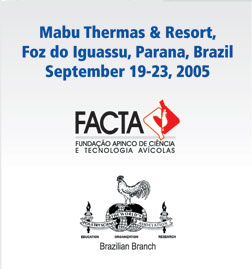THE EFFECT OF LIGHT INTENSITY
DURING BROODING ON THE PRODUCTIVITY AND HEALTH OF
PARACOX-5 VACCINATED BROILERS
Luciano Gobbi and Raffaele Pezzotti
Schering-Plough Animal Health, Milan, Italy.
luciano.gobbi@spcorp.com
Producers
often try to increase bird activity during brooding
to stimulate water and feed intake, increase growth,
reduce early mortality, and improve subsequent flock
uniformity.
Some experimental studies show that in young chickens,
high intensity light (>70 lux sqm.) significantly
increases activity as compared to low lux regimens
(<20 lux sqm). To further assess the effects of
lighting, a trial was performed in Paracox-5 vaccinated
chickens.
Broiler chicks (Ross 508, 20,000 males and 20,000
females) were placed in one of two experimental houses.
From placement until 4 days of age, both houses received
23 light hours and 1 dark hour. Lighting in one house
was 75 lux and, in the other, 20 lux. After 4 days
of age and until slaughter, light intensity for both
groups was maintained at 20 lux.
Birds were evaluated at 0, 4, and 7 days of life,
and then weekly, until 49 days of life. Statistical
analysis was conducted as a one-way ANOVA and, when
significant, (p<0.05) means were compared by Duncan’s
Multiple Range Test.
Crop palpation to evaluate food and water intake showed
that 8 hours after most birds were placed, 98.5% of
those on 75 lux were filled compared to 83.0% on 20
lux. Early growth rate, liveability and flock uniformity
were increased by higher light intensity, while overall
mortality and the incidence of intestine bacterial
overgrowth were significantly reduced. There were
fewer deaths due to necrotic enteritis in the 75 lux
group during the first 4 days of life. Both groups
demonstrated standard oocyst shedding, but peaked
on day 19 in the 75 lux group as compared to day 27
in the 20 lux group. No coccidiosis outbreaks occurred
in either group.
This study provides compelling evidence that high
intensity light regimens enhance activity in chicks,
which in turn increases feed intake and early growth.
Early complete feed consumption appears to enhance
endogenous trypsin release, protein digestion, and
vaccinal oocyst excystation, which may explain their
earlier multiplication and peak shedding. Light manipulation
during brooding also appears to minimize factors such
as litter eating and dehydration that predispose to
intestinal bacteria overgrowth, possibly necrotic
enteritis and mortality. These results should be confirmed
in additional trials before advising producers to
manipulate light intensity.
